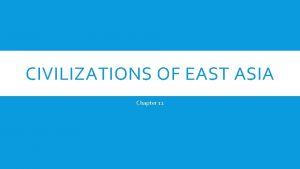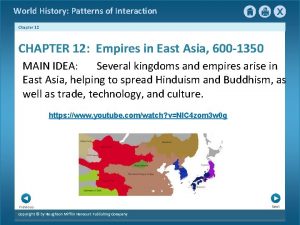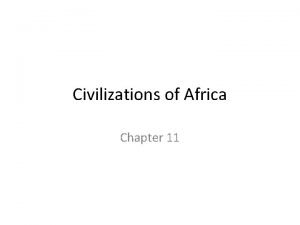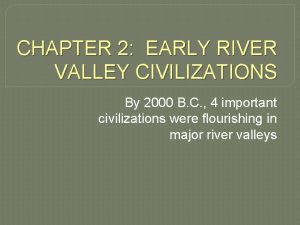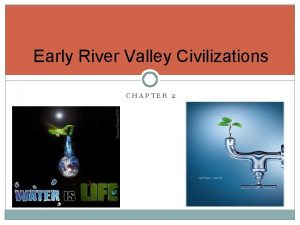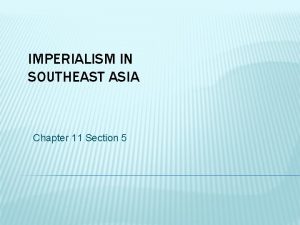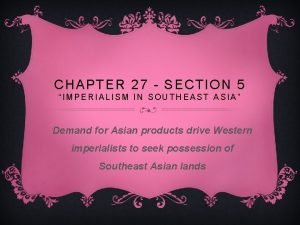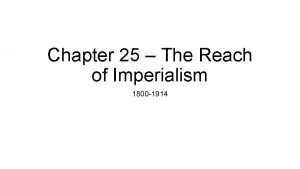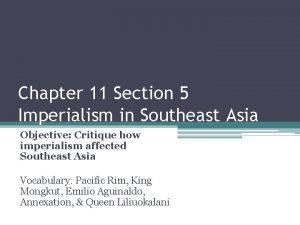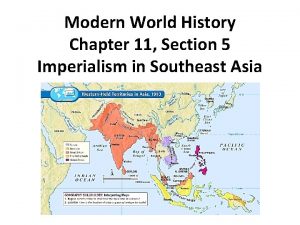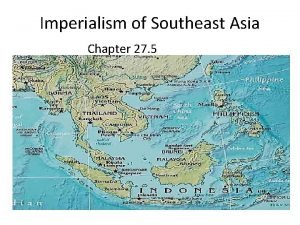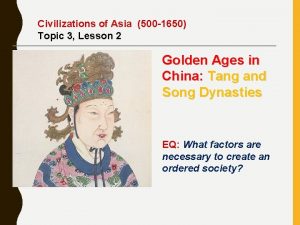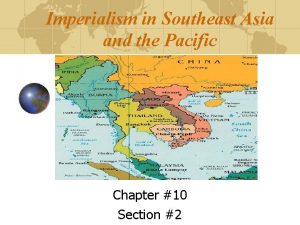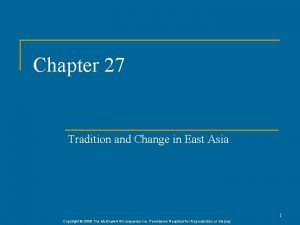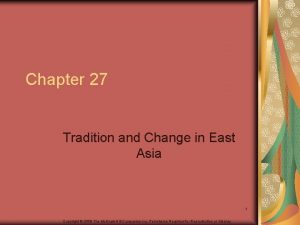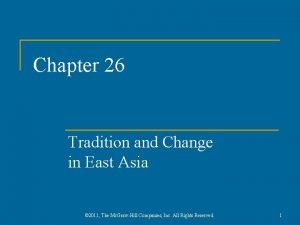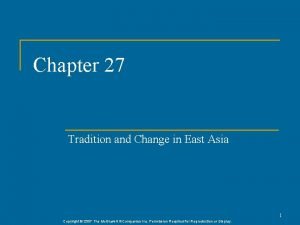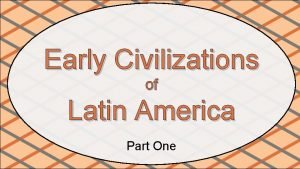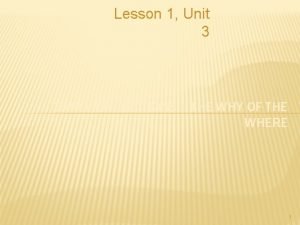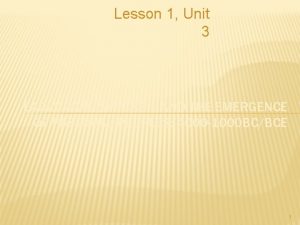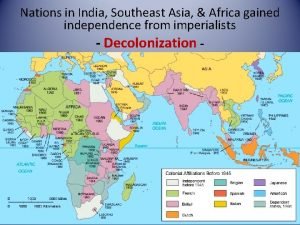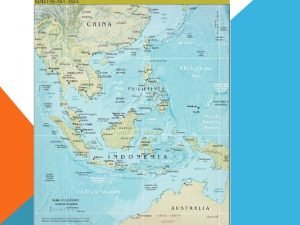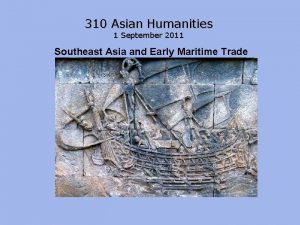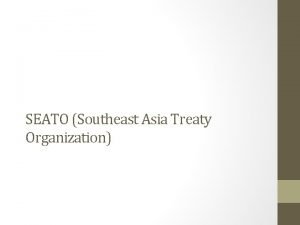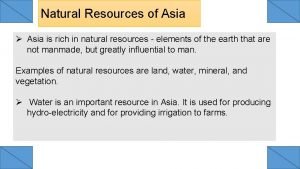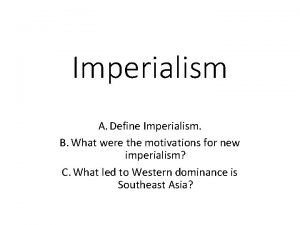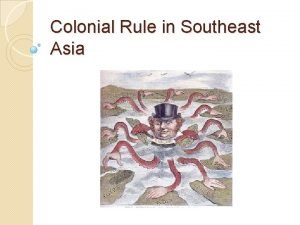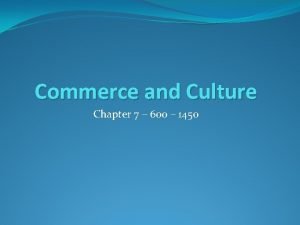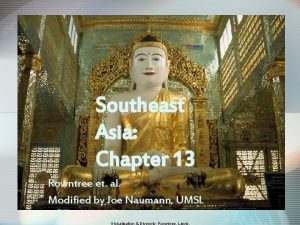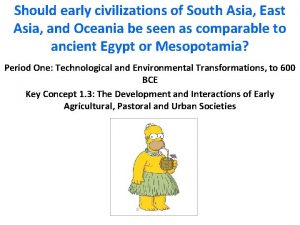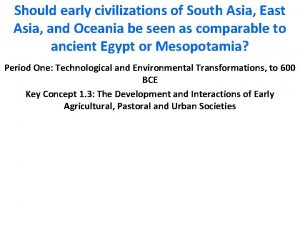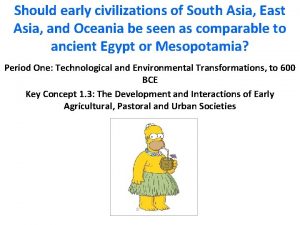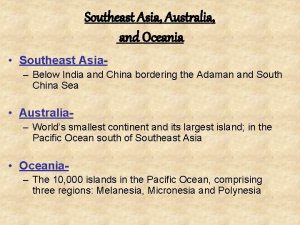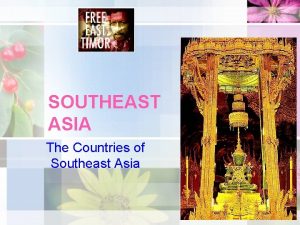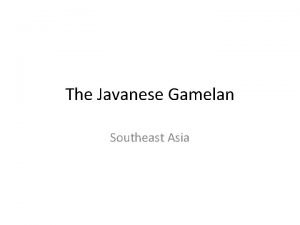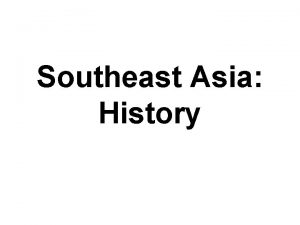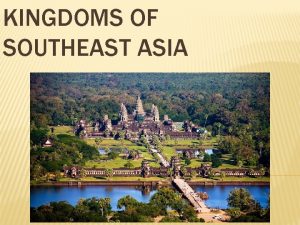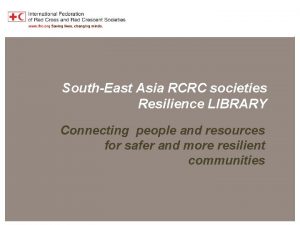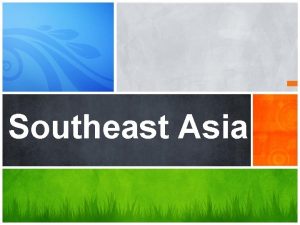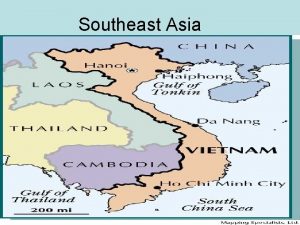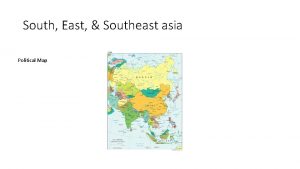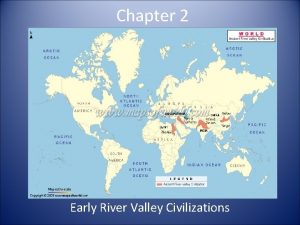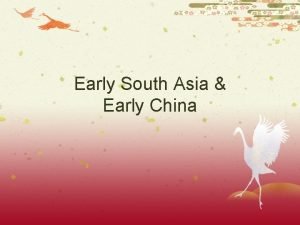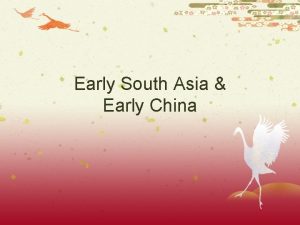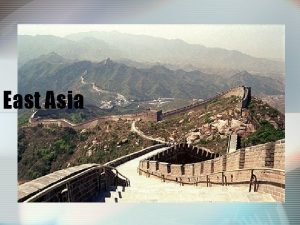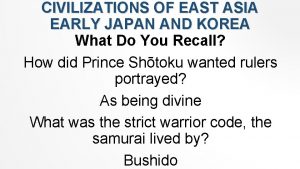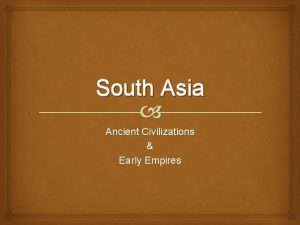Early Civilizations in East and Southeast Asia Chapter





































- Slides: 37

Early Civilizations in East and Southeast Asia Chapter 12

The Tang and Song Dynasties • Europe very divided – fragmented into feudal kingdoms • Unity restored China

Two major dynasties in China TANG DYNASTY • Restores unity in China • Uniform system of government • Land distributed to peasants – land reform • Vietnam, Tibet, and Korea become tributary states • Self-governing, but under Chinese control SONG DYNASTY • China’s wealth and culture dominated • Well-ordered society • New tools for peasants; self-sufficient • Grand Canal – shipping goods to the north • Foreign trade flourished • Threat of invaders – especially Mongols

Tang Dynasty • China was divided for 400 years • 618 – Emergence of Tang under Li Yuan • Li Shimin (Tang Taizong) becomes most admired emperor • Vietnam, Tibet, and Korea become tributary states

Tang Dynasty • Female empress Wu Zhao – uniform government of China • Land reform – broke up pieces of land to distribute to peasants • Decline due to lost territories to Central Asia and Arab countries • Corruption, high taxes, drought, famine, war

Song Dynasty • 960– founded by Zhao Kuangyin • Song ruled 319 years • Great achievements and wealth

Chinese Ordered Society • Gentry value education – wealthy landowning class • Peasants work land • Could move up in society • Slavery was limited • Merchants = lowest class • Riches came from others • Status of women higher than later years • Dowries, foot binding, and more!

The Mongol and Ming Empires • Focus Question: • What are the effects of the Mongol invasion and the rise of the Ming dynasty on China?

Diverse Cultures in Southeast Asia • Geographically separated into two main groups by mountains • Trade routes determined by monsoons

Mongol Empire

The Mongols • Nomadic people • Steppes- vast, treeless plains • Invaded China • Led by Mongol chieftan, Ghengis Khan • Attacked China’s walled cities with cannons and new weapons

Genghis Khan & His Successors • Tolerant leader – as long as he had loyalty • Established peace and order – Pax Mongolica • Cultural exchanges and economic growth

Kublai Khan • Defeated last Song emperor in 1279 • A feat his grandfather could not do • Genghis Khan’s grandson • Did not want Mongols to be absorbed into Chinese civilization

Empire Under Kublai Khan (Mongols) • Only Mongols could serve in military • Highest gov’t jobs could only be served by Mongols • Mix of Chinese and foreign cultures developed • Yuan Dynasty • Welcomed foreigners into his court • Stabilized China • Increased trade

Life in China After Mongols • Kublai Khan dies in 1294 • Marco Polo (Italian explorer) writes about splendor and wealth of China • Outside contact continues – trade • Most Chinese resented the Mongols

The Ming Dynasty • Founded by Zhu Yuanzhang – peasant leader of rebel army – 1368 • Goal: Restore Chinese greatness

Ming Dynasty…con’t • Restore Civil Service System • Economic growth • Chinese culture flourishes • • Painting Poetry Porcelain Novels – early fiction

Zheng He • 1405 – commands first Chinese overseas exploration • Promoted trade • 1435 – Zheng He dies – exploration stops

Korea & its traditions • Table Jigsaw: pg. 386 #2 -5 • Each person narrows their reading focus to one question. • Share answers & have one set per table to share for group discussion.

Japan and the Feudal Age

Geography • Archipelago – chain of islands • 4/5 of land is mountains – people live in river valleys • Too far away for China to conquer; close enough to learn from • Seas = trade routes and FISHING

Forces of Nature • Feared and respected • Ring of Fire – chain of volcanoes • Subject to earthquakes causing tidal waves (tsunamis)

Early Traditions • Divided into clans – each with a chief and god or goddess • 500 – Yamato clan set up the first and only dynasty • Descent from Sun god • Shinto – worship of forces of nature • Korean influence

Chinese Influence • Selective borrowing – kept some Chinese ways, but discarded others • Kana – phonetic symbols representing syllables

Feudal Warfare – 1400 s • Local warlords formed armies to pledge loyalty to them rather than government • Samurai – “those who serve” • Bushido – “way of the warrior” • Honor, bravery, absolute loyalty


Feudalism • Role of women declines • Inheritance limited to sons • Samurai code did not include chivalry • Peasants = backbone of society • Merchants were the lowest class • Gained their wealth from others • Status will improve • Typhoons kept Japan from Mongol invasion

Tokugawa Shogunate • Imposed central government to end feudal warfare • Ruled Japan until 1868 • Created unified, orderly society • Forced daimyo (lords) to live at the capital every other year • Flourishing economy

Zen Buddhism • Zen – Buddhist sect from China • Emphasized self -reliance, meditation, and devotion to duty

Korea • Influenced by China, but kept distinct culture • Location plays huge role • Silla dynasty unites smaller states • Koryo dynasty brings about present-day Korea • 1590 s – Japan invades • Brought many Korean influences to Japan

Section 5: Diverse Cultures of Southeast Asia

Geography • Mainland Southeast Asia • Myanmar, Thailand, Cambodia, Laos, Vietnam, Malaysia • Island Southeast Asia • Indonesia, Singapore, Brunei, the Philippines, 20, 000+ islands

Geography…. con’t • Mainland separated from Asia by mountains • Trade Routes • Shaped by monsoons (seasonal winds) • Linked India, SE Asia, and China to East Africa and the Middle East

Early Traditions • Developed own culture before outside influences arrived • Diverse ethnic groups in isolated villages • Many languages • Nuclear families • Women had more equality

Indian Influence • Indian culture spreads: merchants settled into port cities • Reaches peak between 500 -1000 • Trade brings prosperity = SPICES • Indians bring Islam • Today, Indonesia has the largest Muslim population

Vietnam • Chinese domination • Governmental ideas are adopted • Confucianism, Buddhism and Daoism shaped society • Preserved identity • 939 – broke free from Chinese rule

Chapter 12 Review • Page 404 • #1 -15, 17
 Civilizations of east asia chapter 11
Civilizations of east asia chapter 11 Chapter 12 section 5 kingdoms of southeast asia and korea
Chapter 12 section 5 kingdoms of southeast asia and korea Ancient india lesson 1 early civilizations
Ancient india lesson 1 early civilizations Chapter 11 section 1 early civilizations of africa
Chapter 11 section 1 early civilizations of africa Native american cultural areas
Native american cultural areas River valley civilizations def
River valley civilizations def Chapter 2 early river valley civilizations
Chapter 2 early river valley civilizations Chapter 27 section 5 imperialism in southeast asia
Chapter 27 section 5 imperialism in southeast asia Chapter 27 section 5 imperialism in southeast asia
Chapter 27 section 5 imperialism in southeast asia Chapter 25 lesson 1 colonial rule in southeast asia
Chapter 25 lesson 1 colonial rule in southeast asia Chapter 11 section 5 imperialism in southeast asia
Chapter 11 section 5 imperialism in southeast asia Chapter 11 section 5 imperialism in southeast asia
Chapter 11 section 5 imperialism in southeast asia Chapter 27 section 5 imperialism in southeast asia
Chapter 27 section 5 imperialism in southeast asia Topic 3 review questions civilizations of asia answers
Topic 3 review questions civilizations of asia answers Mainland southeast asia
Mainland southeast asia Imperialism in southeast asia and the pacific
Imperialism in southeast asia and the pacific Chapter 27 tradition and change in east asia
Chapter 27 tradition and change in east asia Chapter 27 tradition and change in east asia
Chapter 27 tradition and change in east asia Chapter 26 tradition and change in east asia
Chapter 26 tradition and change in east asia Chapter 27 tradition and change in east asia
Chapter 27 tradition and change in east asia Early south american civilizations
Early south american civilizations Lesson 1 early civilizations
Lesson 1 early civilizations Lesson 1 early civilizations
Lesson 1 early civilizations Southeast asia urban model
Southeast asia urban model Landforms of southwest asia
Landforms of southwest asia Is india southeast asia
Is india southeast asia Southeast asia climate
Southeast asia climate Chapter 15 lesson 1 physical geography of north africa
Chapter 15 lesson 1 physical geography of north africa Southeast asian alphabets
Southeast asian alphabets Southeast asia treaty organization
Southeast asia treaty organization Natural resources in southeast asia
Natural resources in southeast asia What led to western dominance in southeast asia?
What led to western dominance in southeast asia? Colonial rule in southeast asia
Colonial rule in southeast asia Song dynasty spice chart
Song dynasty spice chart Sea roads as a catalyst for change southeast asia
Sea roads as a catalyst for change southeast asia Countries in southeast asia
Countries in southeast asia Countries in southeast asia
Countries in southeast asia Seapil
Seapil
